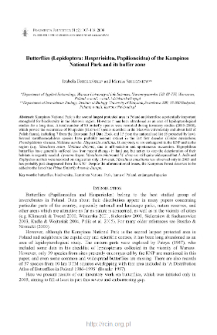- Wyszukaj w całym Repozytorium
- Piśmiennictwo i mapy
- Archeologia
- Baza Młynów
- Nauki przyrodnicze
Wyszukiwanie zaawansowane
Wyszukiwanie zaawansowane
Wyszukiwanie zaawansowane
Wyszukiwanie zaawansowane
Wyszukiwanie zaawansowane

Obiekt
Tytuł: Butterflies (Lepidoptera: Hesperioidea, Papilionoidea) of the Kampinos National Park and its buffer zone
Inny tytuł:
Fragmenta Faunistica, vol. 51, no. 2 ; Butterflies of the Kampinos N. P. ; Motyle dzienne (Papilionoidea i Hesperioidea) Kampinoskiego Parku Narodowego
Współtwórca:
Polska Akademia Nauk. Muzeum i Instytut Zoologii
Wydawca:
Museum and Institute of Zoology, PAS
Miejsce wydania:
Opis:
Bibliogr. s. 116-117 ; S. 107-118 : il. ; 25 cm ; Streszcz. pol. Nazwy taksonów również łac.
Typ obiektu:
Abstrakt:
Kampinoski Park Narodowy jest drugim pod względem wielkości obszarem chronionym w Polsce i stąd ważną ostoją różnorodności biologicznej w skali kraju i Mazowsza. Pomimo sąsiedztwa warszawskiego ośrodka akademickiego, pozostaje jednak terenem słabo zbadanym pod względem fauny bezkręgowców, czego przykładem mogły być przez długi czas motyle dzienne (Papilionoidea i Hesperioidea). Wschodnie części parku były eksplorowane przez Patryna (1947), który włączył dane dotyczące 40 gatunków do spisu motyli zebranych w okolicach Warszawy. Natomiast, analizując informacje zawarte w „Atlasie rozmieszczenia motyli dziennych w Polsce 1986-1995” można wysnuć wniosek o stwierdzeniu 54 gatunków w kwadratach UTM (10 x 10 km) pokrywających się z terenem Puszczy Kampinoskiej (Buszko 1997).W czasie badań inwentaryzacyjnych prowadzonych w latach 2005-2008 obejmujących 9 puszczańskich kwadratów siatki UTM, stwierdziliśmy obecność 80 gatunków tj. 81,6% motyli dziennych woj. mazowieckiego oraz połowę krajowej fauny tej grupy. W sumie z terenu Parku wykazano do tej pory 89 gatunków. Szereg gatunków kserotermofilnych prawdopodobnie wyginęło w ostatnich dekadach tj. Colias myrmidone (Esp.), Pseudophilotes vicrama (Moore), Melitaea aurelia Nick., Hipparchia statilinus (Hufn.), H. alcyone (Den. et Schiff.) lub też jest zagrożona wyginięciem w skali Parku lub regionu jak Maculinea arion (L.) i Melitaea didyma (Esp.) z powodu zalesiania lub naturalnej sukcesji. Fauna motyli higrofilnych generalnie mniej ucierpiała pod wpływem ostatnich zmian użytkowania, ale konieczne są działania mające na celu powstrzymanie obserwowanej degradacji ich siedlisk. Lycaena dispar (Haw.), Maculinea teleius (Bgstr.) i M. alcon (Den. et Schiff.) są wciąż relatywnie rozprzestrzenione ale L. helle (Den. et Schiff.) i Euphydryas aurinia (Rott.) zostały znalezione tylko na pojedynczych stanowiskach. Z kolei M. nausithous (Bgstr.) był obserwowany tylko w 2005 r. i nie można wykluczyć, że byliśmy świadkami jego zniknięcia z terenu KPN. Spośród gatunków znalezionych w czasie ostatniej inwentaryzacji 7 figuruje w Europejskiej Czerwonej Księdze Motyli (van Swaay & Warren 1999), 15 na Polskiej Czerwonej Liście Zwierząt Ginących i Zagrożonych (Buszko i Nowacki 2002), a 8 znajduje się pod ochrona prawną w naszym kraju. W związku z tym Puszcza Kampinoska powinna naszym zdaniem dołączyć do 16 polskich Obszarów o Znaczeniu Pierwszorzędnym dla Motyli (Prime Butterfly Areas) (Buszko 2003).
Czasopismo/Seria/cykl:
Tom:
Zeszyt:
Strona pocz.:
Strona końc.:
Szczegółowy typ zasobu:
Format:
Identyfikator zasobu:
oai:rcin.org.pl:45104 ; 10.3161/00159301FF2008.51.2.107
Źródło:
MiIZ PAN, sygn. patrz sygn. czas. P. 256 vol. 51 no. 2 ; MiIZ PAN, sygn. patrz sygn. czas. P. 4664 vol. 51 no. 2 ; kliknij tutaj, żeby przejść
Język:
Język streszczenia:
Prawa:
Prawa zastrzeżone - dostęp nieograniczony
Zasady wykorzystania:
Digitalizacja:
Muzeum i Instytut Zoologii Polskiej Akademii Nauk
Lokalizacja oryginału:
Biblioteka Muzeum i Instytutu Zoologii PAN
Dofinansowane ze środków:
Program Operacyjny Innowacyjna Gospodarka, lata 2010-2014, Priorytet 2. Infrastruktura strefy B + R ; Unia Europejska. Europejski Fundusz Rozwoju Regionalnego
Dostęp:
Kolekcje, do których przypisany jest obiekt:
- Repozytorium Cyfrowe Instytutów Naukowych > Kolekcje Partnerów > Muzeum i Instytut Zoologii PAN > Czasopisma
- Repozytorium Cyfrowe Instytutów Naukowych > Kolekcje Partnerów > Muzeum i Instytut Zoologii PAN > Wydawnictwa MiIZ PAN > Fragmenta Faunistica
- Repozytorium Cyfrowe Instytutów Naukowych > Piśmiennictwo > Czasopisma/Artykuły
Data ostatniej modyfikacji:
4 lut 2025
Data dodania obiektu:
13 maj 2014
Liczba pobrań / odtworzeń:
1222
Wszystkie dostępne wersje tego obiektu:
https://rcin.org.pl./publication/54183
Wyświetl opis w formacie RDF:
Wyświetl opis w formacie RDFa:
Wyświetl opis w formacie OAI-PMH:
Obiekty Podobne
Buczyński, Paweł Buczyńska, Edyta Tarkowski, Adam Tańczuk, Agnieszka Bojar, Paweł
Kowalczyk, Jan K. Zieliński, Sławomir
Kowalczyk, Jan Krzysztof Kurzac, Tadeusz

 INSTYTUT ARCHEOLOGII I ETNOLOGII POLSKIEJ AKADEMII NAUK
INSTYTUT ARCHEOLOGII I ETNOLOGII POLSKIEJ AKADEMII NAUK
 INSTYTUT BADAŃ LITERACKICH POLSKIEJ AKADEMII NAUK
INSTYTUT BADAŃ LITERACKICH POLSKIEJ AKADEMII NAUK
 INSTYTUT BADAWCZY LEŚNICTWA
INSTYTUT BADAWCZY LEŚNICTWA
 INSTYTUT BIOLOGII DOŚWIADCZALNEJ IM. MARCELEGO NENCKIEGO POLSKIEJ AKADEMII NAUK
INSTYTUT BIOLOGII DOŚWIADCZALNEJ IM. MARCELEGO NENCKIEGO POLSKIEJ AKADEMII NAUK
 INSTYTUT BIOLOGII SSAKÓW POLSKIEJ AKADEMII NAUK
INSTYTUT BIOLOGII SSAKÓW POLSKIEJ AKADEMII NAUK
 INSTYTUT CHEMII FIZYCZNEJ PAN
INSTYTUT CHEMII FIZYCZNEJ PAN
 INSTYTUT CHEMII ORGANICZNEJ PAN
INSTYTUT CHEMII ORGANICZNEJ PAN
 INSTYTUT FILOZOFII I SOCJOLOGII PAN
INSTYTUT FILOZOFII I SOCJOLOGII PAN
 INSTYTUT GEOGRAFII I PRZESTRZENNEGO ZAGOSPODAROWANIA PAN
INSTYTUT GEOGRAFII I PRZESTRZENNEGO ZAGOSPODAROWANIA PAN
 INSTYTUT HISTORII im. TADEUSZA MANTEUFFLA POLSKIEJ AKADEMII NAUK
INSTYTUT HISTORII im. TADEUSZA MANTEUFFLA POLSKIEJ AKADEMII NAUK
 INSTYTUT JĘZYKA POLSKIEGO POLSKIEJ AKADEMII NAUK
INSTYTUT JĘZYKA POLSKIEGO POLSKIEJ AKADEMII NAUK
 INSTYTUT MATEMATYCZNY PAN
INSTYTUT MATEMATYCZNY PAN
 INSTYTUT MEDYCYNY DOŚWIADCZALNEJ I KLINICZNEJ IM.MIROSŁAWA MOSSAKOWSKIEGO POLSKIEJ AKADEMII NAUK
INSTYTUT MEDYCYNY DOŚWIADCZALNEJ I KLINICZNEJ IM.MIROSŁAWA MOSSAKOWSKIEGO POLSKIEJ AKADEMII NAUK
 INSTYTUT PODSTAWOWYCH PROBLEMÓW TECHNIKI PAN
INSTYTUT PODSTAWOWYCH PROBLEMÓW TECHNIKI PAN
 INSTYTUT SLAWISTYKI PAN
INSTYTUT SLAWISTYKI PAN
 SIEĆ BADAWCZA ŁUKASIEWICZ - INSTYTUT TECHNOLOGII MATERIAŁÓW ELEKTRONICZNYCH
SIEĆ BADAWCZA ŁUKASIEWICZ - INSTYTUT TECHNOLOGII MATERIAŁÓW ELEKTRONICZNYCH
 MUZEUM I INSTYTUT ZOOLOGII POLSKIEJ AKADEMII NAUK
MUZEUM I INSTYTUT ZOOLOGII POLSKIEJ AKADEMII NAUK
 INSTYTUT BADAŃ SYSTEMOWYCH PAN
INSTYTUT BADAŃ SYSTEMOWYCH PAN
 INSTYTUT BOTANIKI IM. WŁADYSŁAWA SZAFERA POLSKIEJ AKADEMII NAUK
INSTYTUT BOTANIKI IM. WŁADYSŁAWA SZAFERA POLSKIEJ AKADEMII NAUK




































